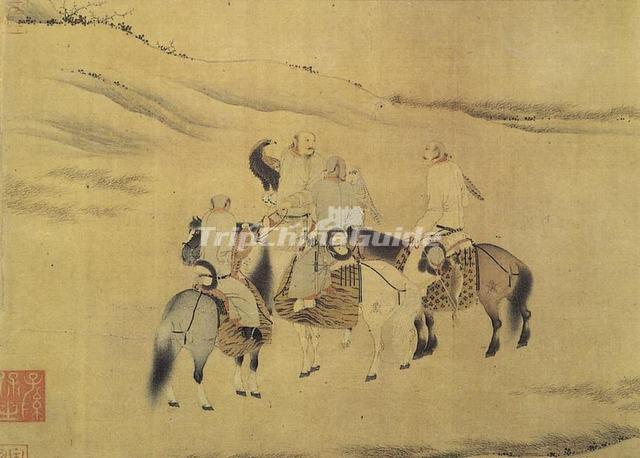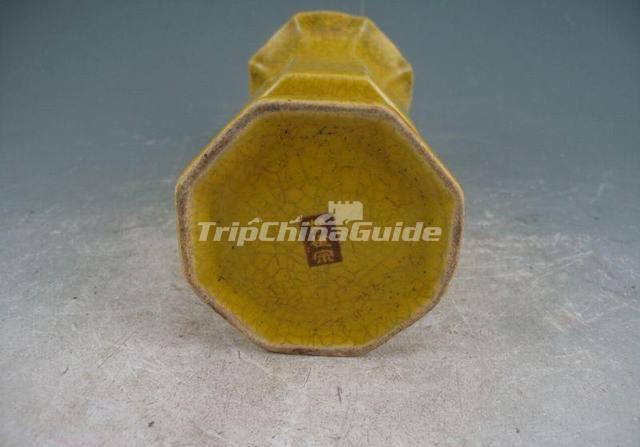Five Dynasties and Ten Kingdoms
The time from 907-960 A.D. is called The Five Dynasties. However, numerous small kingdoms also existed. The Five Dynasties are the officially recognized dynasties of the north, while the south had ten kingdoms. The north was continually ravaged by warfare during this time as they were attacked time and again by the Khitans and the Turks. Conversely, the south enjoyed a time of peace, economic prosperity, and cultural growth. The leaders of the southern kingdoms were often the military governors of the Tang dynasty.
Despite the political division of China, four important advances occurred. In the south, trade became increasingly important, especially the tea trade. Efforts at state monopolization occurred in an attempt to control the revenue of the tea trade. Salt monopolies were developed and the salt tax was the top budget item during this period. The second development was translucent porcelain. This also happened in the south and was used both within China and as an export item. The next important development was in the field of printing. In about 940 A.D., the first printing of the Classics occurred. Attempts at movable type began in about 1045 A.D. Printing had far reaching effects on the Chinese people. As would occur later in Europe, printing allowed more people to become educated as books became more readily available. The availability of books also allowed for private libraries. Finally, in northern China, paper money was introduced. This introduction was due in part to the fact that metal is scarce in China. Also, the existing copper money was very heavy and difficult to transport. The beginnings of paper money were deposit certificates that merchants used in provinces that prohibited the export of copper coins. Eventually, the government would accept copper and then issue certificates, thus creating a banking system. This money system greatly increased trade.
The practice of binding women's feet also began during this time. The first evidence of this practice shows up in about 950 A.D. Scholars are not sure why this practice began, however, it was widely practiced among both the rich and poor of China. Only a few groups did not participate in this custom. They were the boat women of Guangdong and the aboriginal people of the southwest. None of the non-Chinese groups surrounding China participated in this custom.
Buddhism experienced a sharp decline during this period. In northern China, Buddhism was heavily persecuted beginning in 955 A.D. This persecution seemed to be aimed at stopping men from becoming monks to avoid joining the armies. Many regulations were put in place. 30,336 temples and monasteries were secularized, and many monks were forced to leave the monasteries and take up secular lives. The construction of temples and monasteries was limited, as private people could no longer build them and each district was limited to a certain number of temples. Monks were also required to carry six identification cards.
Emperors of the Five Dynasties and Ten Kingdoms
Temple Names | Posthumous Names | Personal Names | Reign years | Era Names and range of Years | ||||
The Five Dynasties | ||||||||
Taìzǔ | 太祖 | Xiànwǔ | 獻武 | Zhū Wēn | 朱溫 | 907-912 | Kaīpíng (开平) 907-911 | |
Qiánhuà (乾化) 911-912 | ||||||||
None | None | Zhu Yougui | 朱友珪 | 912-913 | Qiánhuà (乾化) 912-913 | |||
Fengli 913 | ||||||||
Did not exist | Mòdì | 末帝 | Zhū Zhèn | 朱瑱 | 913-923 | Qiánhuà (乾化) 913-915 | ||
Zhēnmíng (贞明) 915-921 | ||||||||
Lóngdé (龙德) 921-923 | ||||||||
Hou (Later) Tang Dynasty 923-936 | ||||||||
Zhuāngzōng | 莊宗 | No | Lǐ Cúnxù | 李存勗 | 923-926 | Tóngguāng同光 923-926 | ||
Míng zōng | 明宗 | No | Lǐ Sì Yuán or Lǐ Dǎn | 李嗣源 or李亶 | 926-933 | Tiān chéng天成926-930 | ||
Cháng xīng長興 930-933 | ||||||||
Did not exist | Mǐndì | 閔帝 | Lǐ Cóng hòu | 李從厚 | 933-934 | Yìngshùn應順 933-934 | ||
Did not exist | Mò dì | 末帝 | Lǐ Cóng kē | 李從珂 | 934-936 | Qīngtaì清泰 934-936 | ||
Hou (Later) Jin Dynasty 936-947 | ||||||||
gao zu | 高祖 | No | Shi Jingtang | 石敬瑭 | 936-942 | Tianfu天福 936-942 | ||
Did not exist | Chu Di | 出帝 | Shi Chonggui | 石重貴 | 942-947 | Tianfu 天福 942-944 | ||
Kaiyun開運 944-947 | ||||||||
Hou (Later) Han Dynasty 947-950 | ||||||||
Gao Zu | 高祖 | No | Liu Zhiyuan | 劉知遠 | 947-948 | Tianfu 天福 947 | ||
Qianyou 乾祐 948 | ||||||||
Did not exist | Yin Di | 隱帝 | Liu Chengyou | 劉承祐 | 948-950 | Qianyou 乾祐 948-950 | ||
Hou (Later) Zhou Dynasty 951-960 | ||||||||
Tai Zu | 太祖 | No | Guo Wei | 郭威 | 951-954 | Guangshun 廣順 951-954 | ||
Xiande 顯德 954 | ||||||||
Shi Zong | 世宗 | No | Chai Rong | 柴榮 | 954-959 | Xiande顯德 954-959 | ||
Did not exist | Gong Di | 恭帝 | Chai Zongxun | 柴宗訓 | 959-960 | Xiande 顯德 959-960 | ||
The Ten Kingdoms | ||||||||
Wu Yue Kingdom 904-978 | ||||||||
Tai Zu | 太祖 | Wu Su Wang | 武肅王 | Qian Liu | 錢鏐 | 904-932 | Tianbao天寶 908-923 | |
Baoda寶大 923-925 | ||||||||
Baozheng寶正 925-932 | ||||||||
Shi Zong | 世宗 | Wen Mu Wang |
| Qian Yuanguan | 錢元瓘 | 932-941 | Did not exist | |
Cheng Zong | 成宗 | Zhong Xian Wang | 忠獻王 | Qian Zuo | 錢佐 | 941-947 | Did not exist | |
Did not exist | Zhong Xun Wang | 忠遜王 | Qian Zong | 錢倧 | 947 | Did not exist | ||
Did not exist | Zhong Yi Wang | 忠懿王 | Qian Chu | 錢俶 | 947-978 | Did not exist | ||
Min Kingdom 909-945 including Yin Kingdom 943-945 | ||||||||
Tai Zu | 太祖 | Zhong Yi Wang | 忠懿王 | Wang Shenzhi | 王審知 | 909-925 | Did not exist | |
Did not exist | Did not exist | Wang Yanhan | 王延翰 | 925-926 | Did not exist | |||
Tai Zong | 太宗 | Hui Di | 惠帝 | Wang Yanjun | 王延鈞 | 926-935 | Longqi 龍啟 933-935 | |
Yonghe 永和 935 | ||||||||
Kang Zong | 康宗 | No | Wang Jipeng | 王繼鵬 | 935-939 | Tongwen 通文 936-939 | ||
Jing Zong | 景宗 | No | Wang Yanxi | 王延羲 | 939-944 | Yonglong 永隆 939-944 | ||
Did not exist | Tian De Di | 天德帝 | Wang Yanzheng | 王延政 | 943-945 | Tiande 天德 943-945 | ||
Jing Nan or Nan Ping Kingdom 906-963 | ||||||||
Did not exist | Wu Xin Wang |
| Gao Jixing | 高季興 | 909-928 | Did not exist | ||
Did not exist | Wen Xian Wang |
| Gao Conghui | 高從誨 | 928-948 | Did not exist | ||
Did not exist | Zhen Yi Wang |
| Gao Baorong | 高寶融 | 948-960 | Did not exist | ||
Did not exist | Shi Zhong |
| Gao Baoxu | 高寶勗 | 960-962 | Did not exist | ||
Did not exist | Did not exist | Gao Jichong | 高繼沖 | 962-963 | Did not exist | |||
Chu Kingdom 897-951 | ||||||||
Did not exist | Wu Mu Wang | 武穆王 | Ma Yin | 馬殷 | 897-930 | Did not exist | ||
Did not exist | Heng Yang Wang |
| Ma Xisheng | 馬希聲 | 930-932 | Did not exist | ||
Did not exist | Wen Zhao Wang | 文昭王 | Ma Xifan | 馬希範 | 932-947 | Did not exist | ||
Did not exist | Fei Wang | 廢王 | Ma Xiguang | 馬希廣 | 947-950 | Did not exist | ||
Did not exist | Gong Xiao Wang |
| Ma Xi E | 馬希萼 | 950 | Did not exist | ||
Did not exist | Did not exist | Ma Xichong | 馬希崇 | 950-951 | Did not exist | |||
Wu Kingdom 904-937 | ||||||||
Tai Zu | 太祖 | Xiao Wu Di |
| Yang Xingmi | 楊行密 | 904-905 | Tianyou 天祐 904-905 | |
Lie Zong | 烈宗 | Jing Di | 景帝 | Yang Wo | 楊渥 | 905-908 | Tianyou 天祐 905-908 | |
Gao Zu | 高祖 | Xuan Di | 宣帝 | Yang Longyan | 楊隆演 | 908-921 | Tianyou 天祐 908-919 | |
Wuyi 武義 919-921 | ||||||||
Did not exist | Rui Di | 睿帝 | Yang Pu | 楊溥 | 921-937 | Shunyi順義 921-927 | ||
Qianzhen乾貞 927-929 | ||||||||
Dahe大和 929-935 | ||||||||
Tianzuo天祚 935-937 | ||||||||
Nan (Southern) Tang Kingdom 937-975 | ||||||||
Xian Zhu or Lie Zu | 先主or 烈祖 | No | Li Bian | 李昪 | 937-943 | Shengyuan 昇元 937-943 | ||
Zhong Zhu or Yuan Zong | 中主 or元宗 | No | Li Jing | 李璟 | 943-961 | Baoda 保大 943-958 | ||
Jiaotai 交泰 958 | ||||||||
Zhongxing 中興 958 | ||||||||
Hou Zhu | 後主 | Wu Wang |
| Li Yu | 李煜 | 961-975 | Did not exist | |
Nan (Southern) Han Kingdom 917-971 | ||||||||
Gao Zu | 高祖 | Tian Huang Da Di | 天皇大帝 | Liú Yán or Liú Yǎn | 劉巖 or劉龑 | 917-925 | Qiánhēng (乾亨) 917-925 | |
Báilóng (白龍) 925-928 | ||||||||
Dàyǒu (大有) 928-941 | ||||||||
Did not exist | Shang Di | 殤帝 | Liu Fen | 劉玢 | 941-943 | Guāngtiān (光天) 941-943 | ||
Zhong Zong | 中宗 | No | Liu Sheng | 劉晟 | 943-958 | Yìngqián (應乾) 943 | ||
Qiánhé (乾和) 943-958 | ||||||||
Hou Zhu | 後主 | Did not exist | Liu Chang | 劉鋹 | 958-971 | Dàbbǎo (大寶) 958-971 | ||
Bei (Northern) Han Kingdom 951-979 | ||||||||
Shi Zu | 世祖 | Shen Wu Di | 神武帝 | Liu Min | 劉旻 | 951-954 | Qianyou 乾祐 951-954 | |
Rui Zong | 睿宗 | Xiao He Di | 孝和帝 | Liu Chengjun | 劉承鈞 | 954-970 | Qianyou 乾祐 954-957 | |
Tianhui 天會 957-970 | ||||||||
Shao Zhu | 少主 | Did not exist | Liu Jien | 劉繼恩 | 970 | Did not exist | ||
Did not exist | Ying Wu Di | 英武帝 | Liu Jiyuan | 劉繼元 | 970-982 | Guangyun 廣運 970-982 | ||
Qian (Former) Shu Kingdom 907-925 | ||||||||
Gao Zu | 高祖 | No | Wang JIan | 王建 | 907-918 | Tianfu 天復 907 | ||
Wucheng 武成 908-910 | ||||||||
Yongping 永平 911-915 | ||||||||
Tongzheng通正 916 | ||||||||
Tianhan 天漢 917 | ||||||||
Guangtian 光天 918 | ||||||||
Hou Zhu | 後主 | Did not exist | Wang Yan | 王衍 | 918-925 | Qiande 乾德 918-925 | ||
Xiankang咸康 925 | ||||||||
Hou (Later) Shu Kingdom 934-965 | ||||||||
Gao Zu | 高祖 | No | Meng Zhixinag | 孟知祥 | 934 | Mingde明德 934 | ||
Hou Zhu | 後主 | Did not exist | Meng Chang | 孟昶 | 938-965 | Mingde明德 934-938 | ||
Guangzheng廣政 938-965 | ||||||||
Recommended China Tour Packages
-
5-day Chengdu and Taoping Qiang Village Tour
-
8-day China Jewish Heritage Tour
-
Suzhou & Zhouzhuang Day Trip from Shanghai















